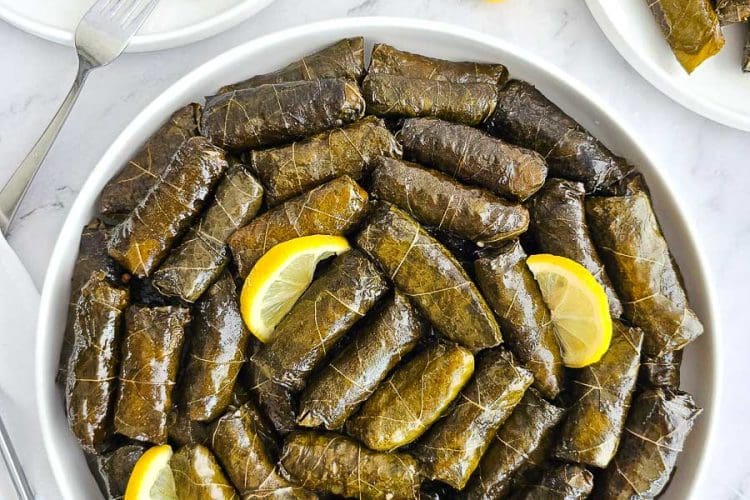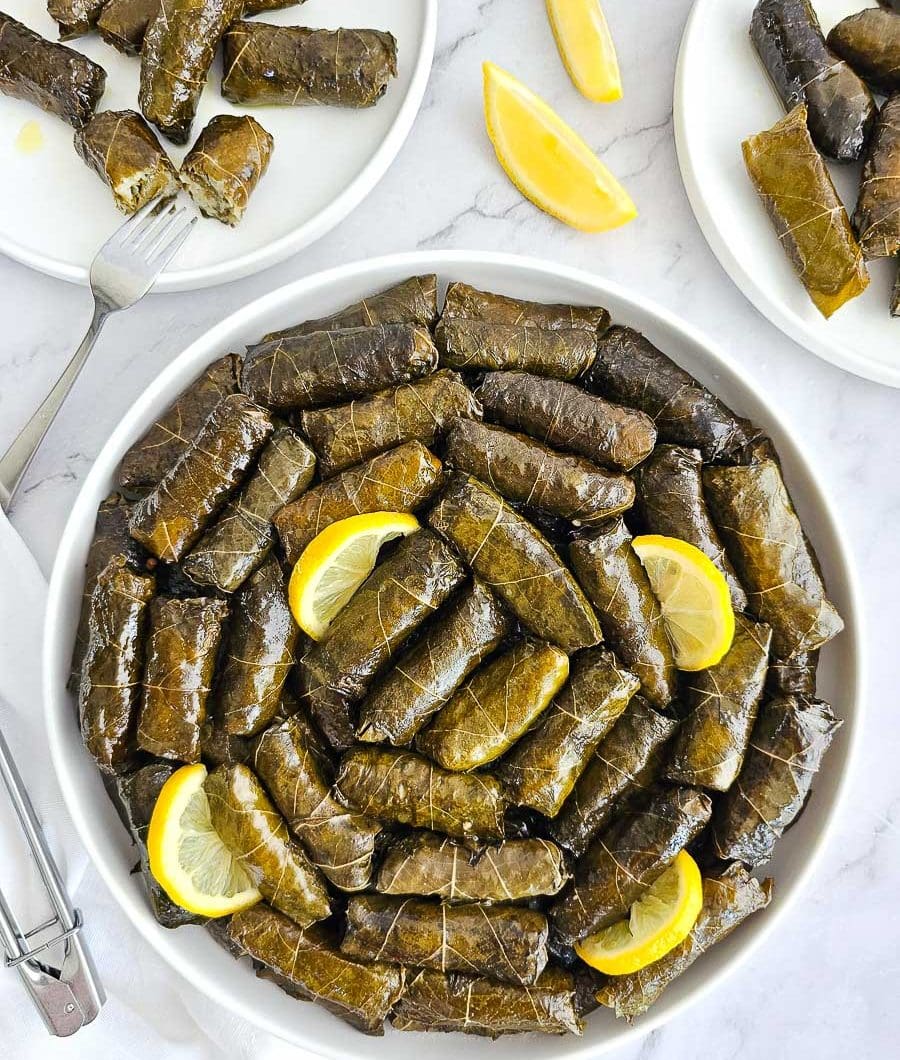These Stuffed Vine Leaves, known as Dolmades Yialantzi, are a delicious vegan take on a classic dish. Packed with rice, fresh herb and lots of onions, they are gently simmered in an olive oil and lemon sauce until the leaves are tender and the rice is perfectly cooked.
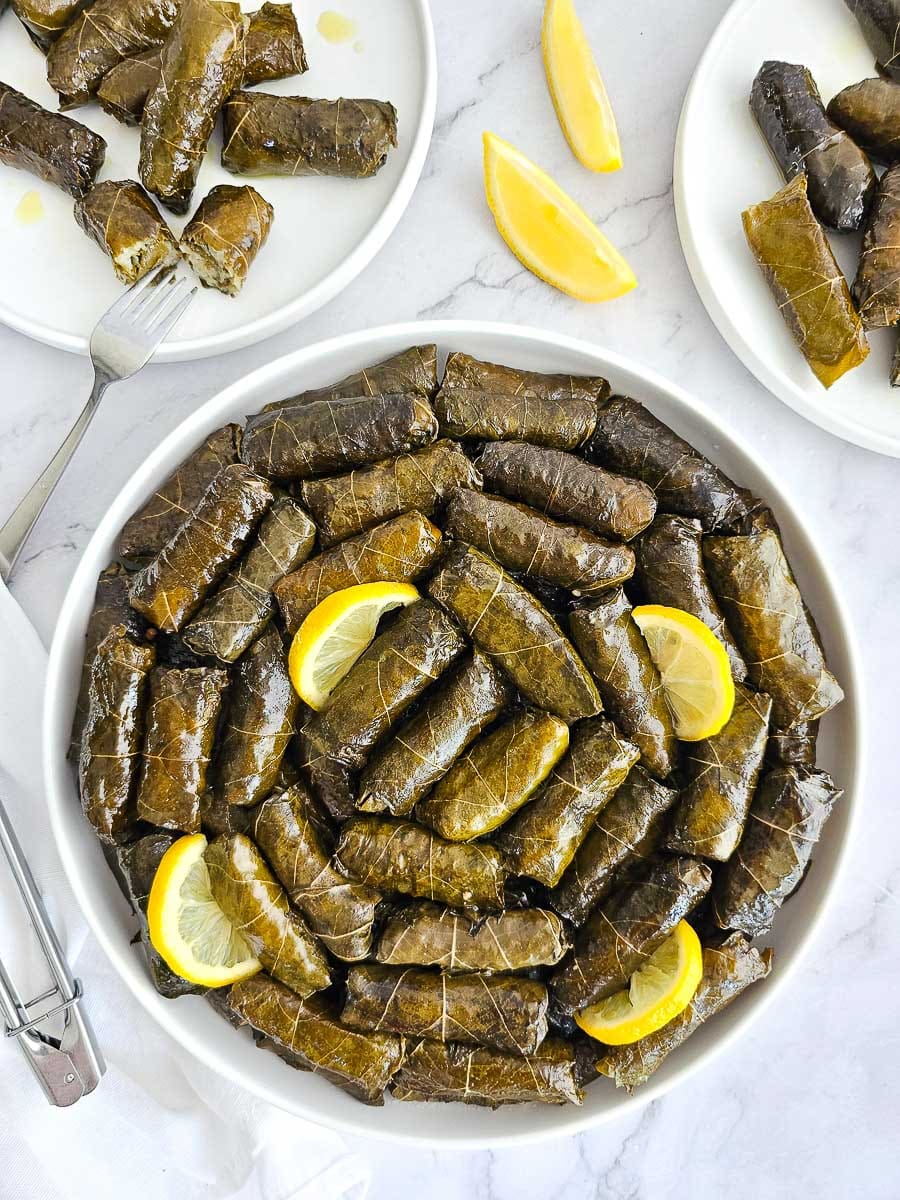
Dolmades can be made in two different ways. The traditional version features a filling of meat, rice and herbs, while this recipe is the vegan option filled with rice, herbs and onions. The vegan version is known as ‘Dolmades Yialantzi,’ which, in Turkish, means ‘fake stuffed.’ This term refers to the meatless version filled with rice, herbs and onions, in contrast to the traditional ‘dolma,’ which usually includes meat.
I often find myself torn between which version of dolmades I prefer, but Dolmades Yialantzi hold a special place in my heart because they were my aunt’s specialty. Whenever we gathered as a family, she would make dolmades that were always a hit – tender, full of flavour, and perfectly balanced with olive oil, herbs, and just the right amount of lemon juice. Her recipe is simple: prepare the filling, roll it in vine leaves, and gently simmer in an olive oil and lemon broth, creating a dish that tastes just like home.
Ingredients for Stuffed Vine Leaves (Dolmades Yialantzi)
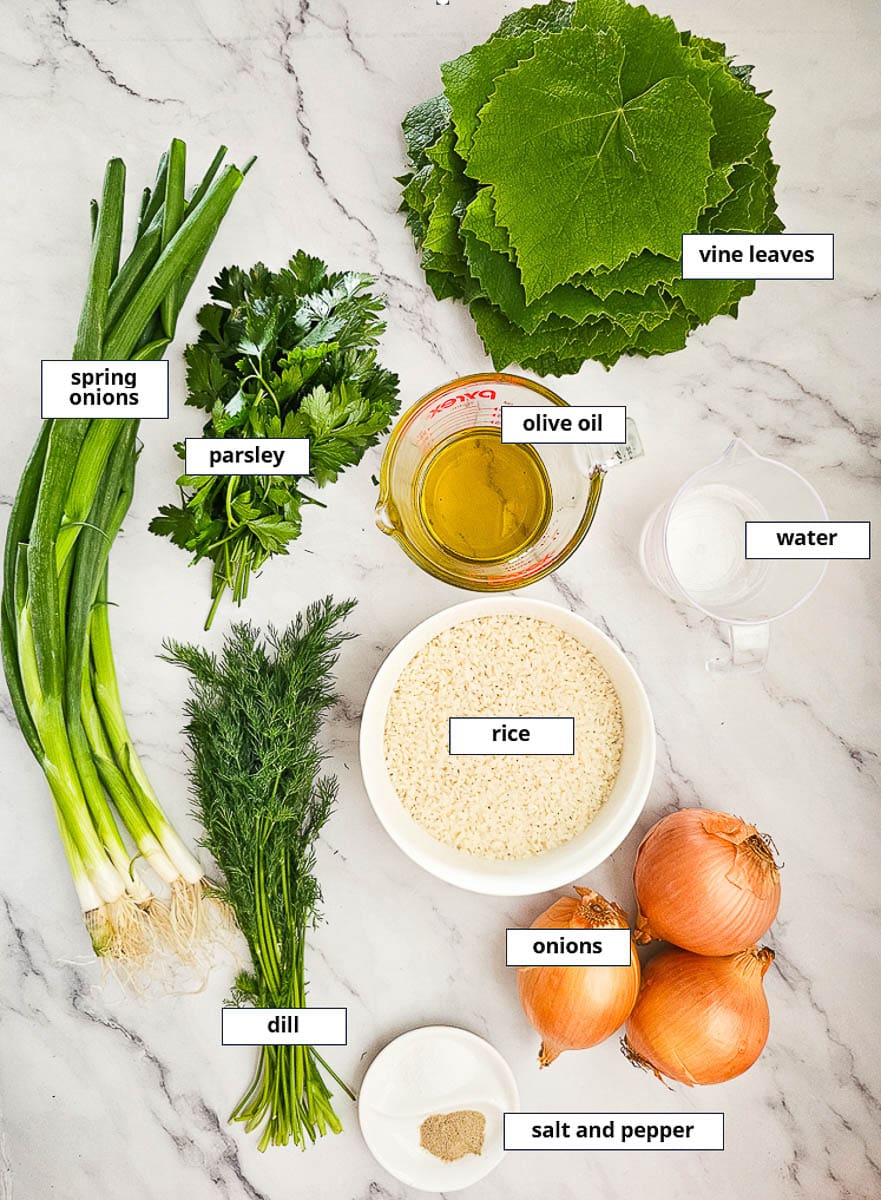
- Vine leaves / Grape leaves: I prefer the fresh vine leaves, if you are lucky enough to grow them or have a neighbour that grows them, as they have a milder flavour than the jarred ones soaked in brine. For fresh leaves, choose tender, soft, light-green leaves without blemishes. I blanch them and freeze in batches of 25 to enjoy year-round. If using jarred or packaged vine leaves, you can find them in Mediterranean stores, delicatessens, or the international aisle at supermarkets. Since they can be quite salty, rinse the leaves well and blanch briefly to reduce the briny taste.
- Onions: Use plenty of onions, as they add a subtle sweetness to the filling, enhancing the overall flavour of the dolmades.
- Spring onions / scallions: Finely chop lots of shallots to add a mild sweetness and depth to the filling.
- Rice: Use medium grain rice, as it absorbs flavours well and becomes tender while still holding its shape.
- Herbs: Parsley and dill give the dolmades a fresh aromatic flavour, you can add more if you like.
- Lemon Juice: Always use fresh lemon juice instead of bottled varieties to achieve the best flavour.
- Olive oil: Use extra virgin olive oil for the best flavour. It not only binds the ingredients together but also contributes a smooth texture to the filling, enhancing the overall taste of the dolmades.
Ingredients for Cooking Liquid
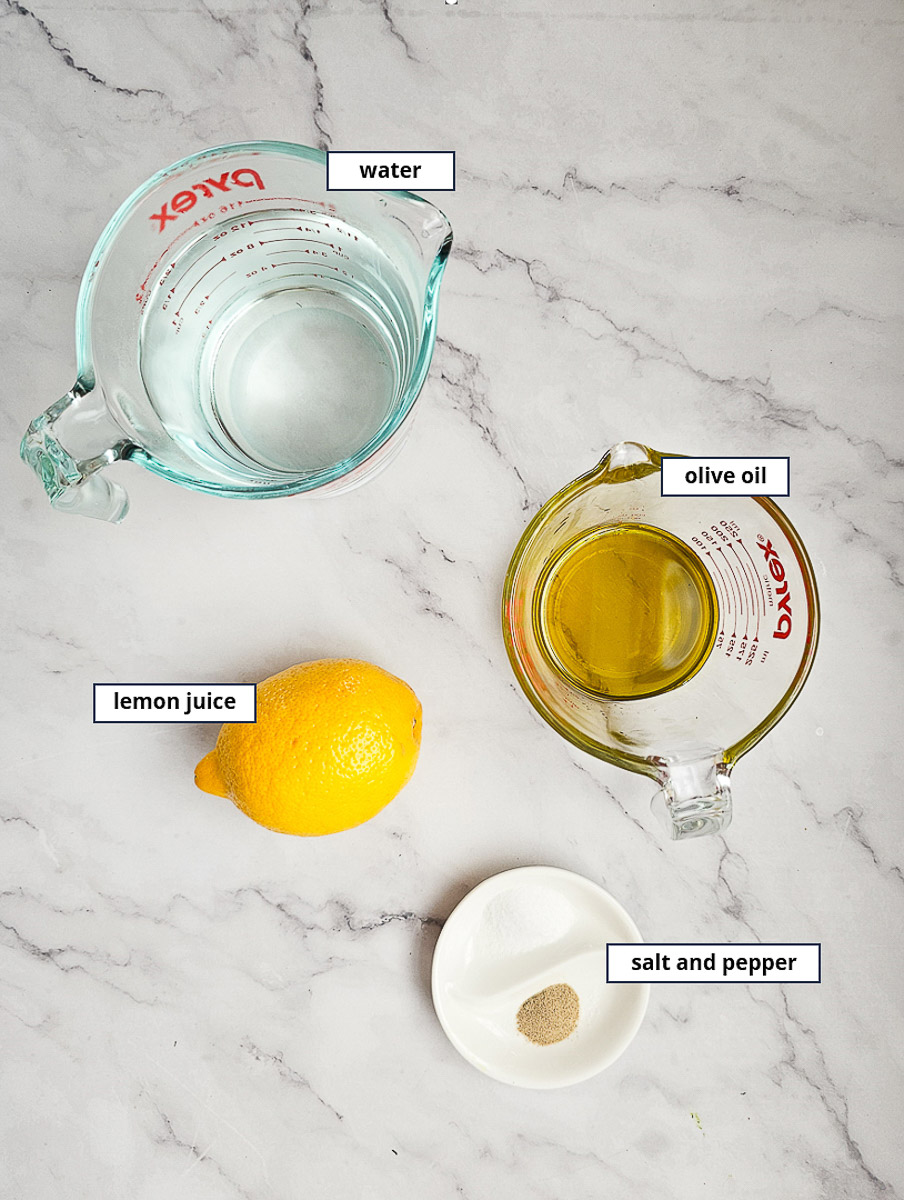
How to make Stuffed Vine Leaves (Dolmades Yialantzi)
To Prepare Fresh Vine Leaves
If using vine leaves from a jar or packet soaked in brine, refer to the preparation instructions in the recipe.
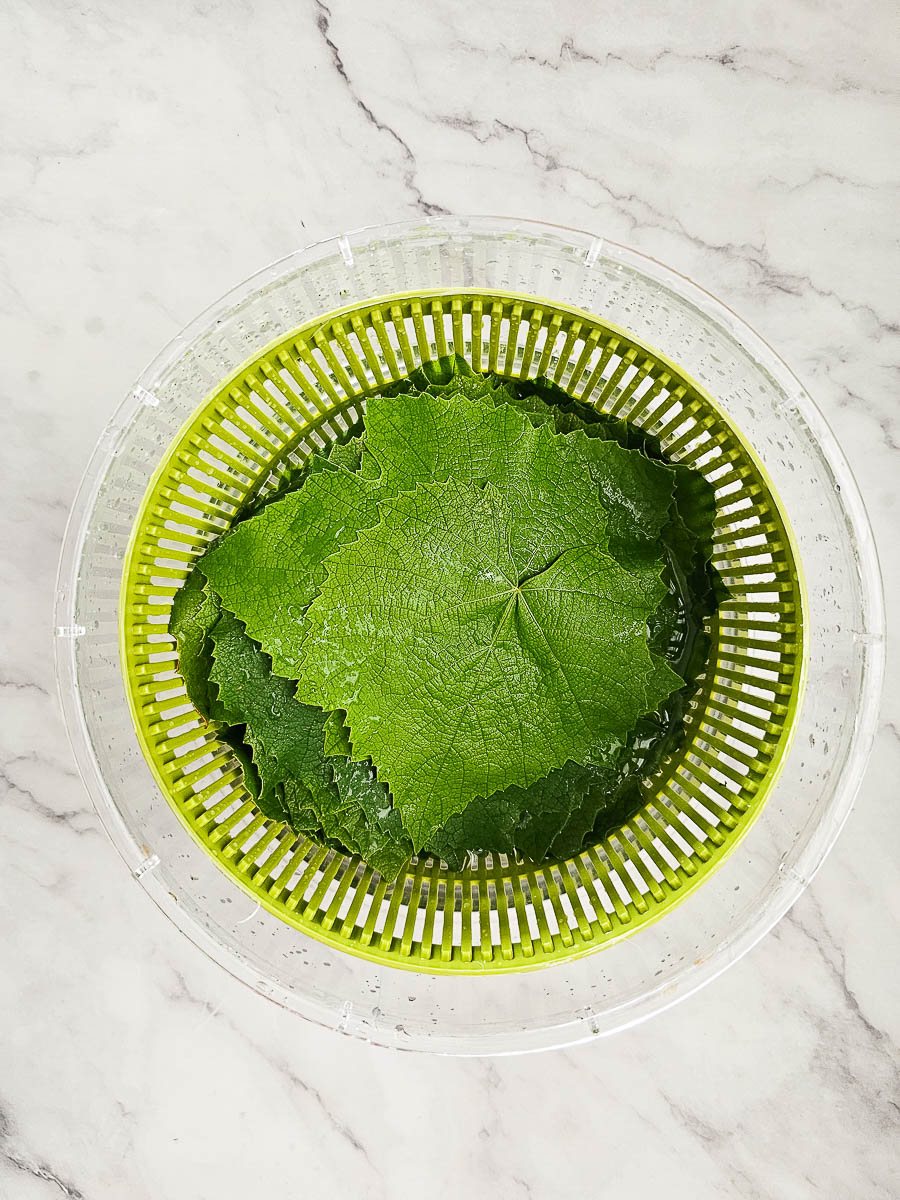
1. Rinse fresh vine leaves well under cold water.
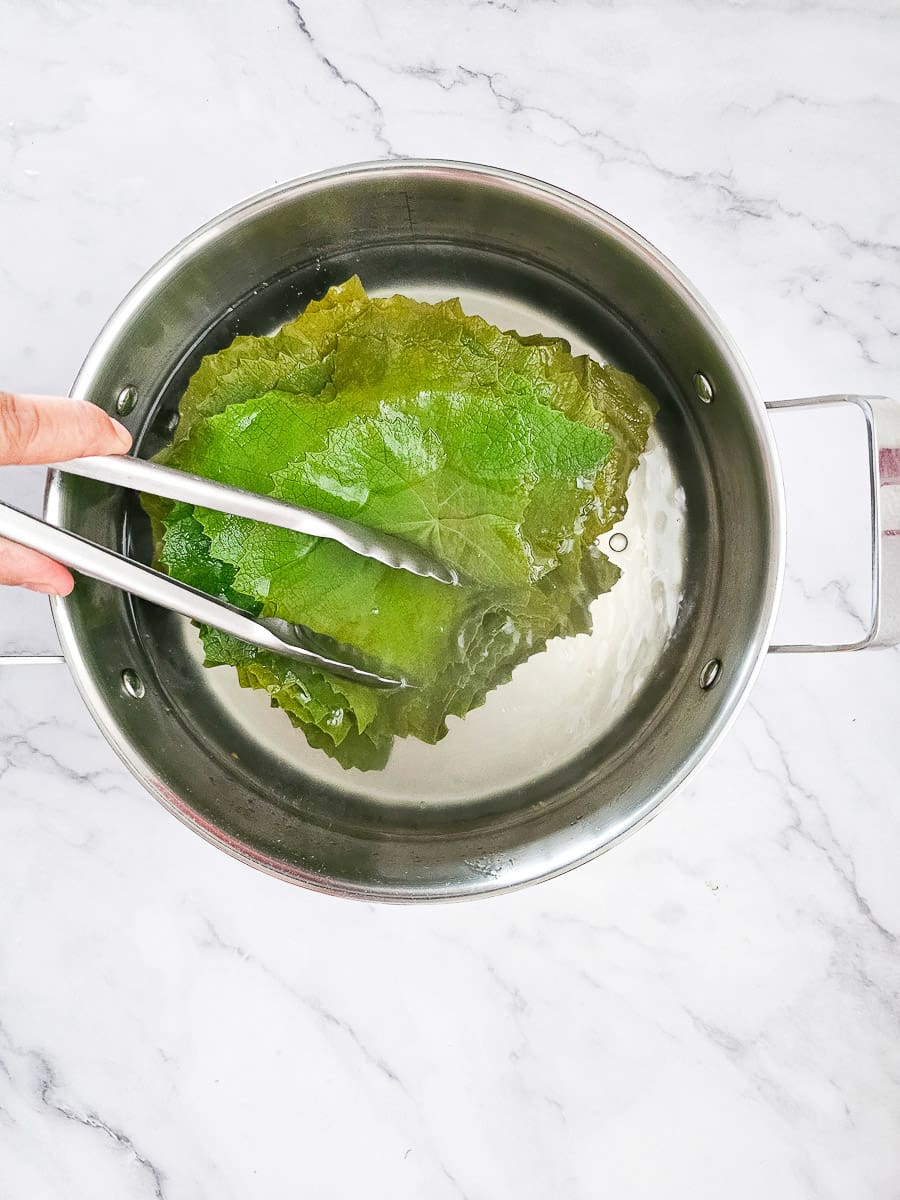
2. In a medium pot, bring water to the boil. Add salt and oil. Blanch the vine leaves for 1-2 minutes.
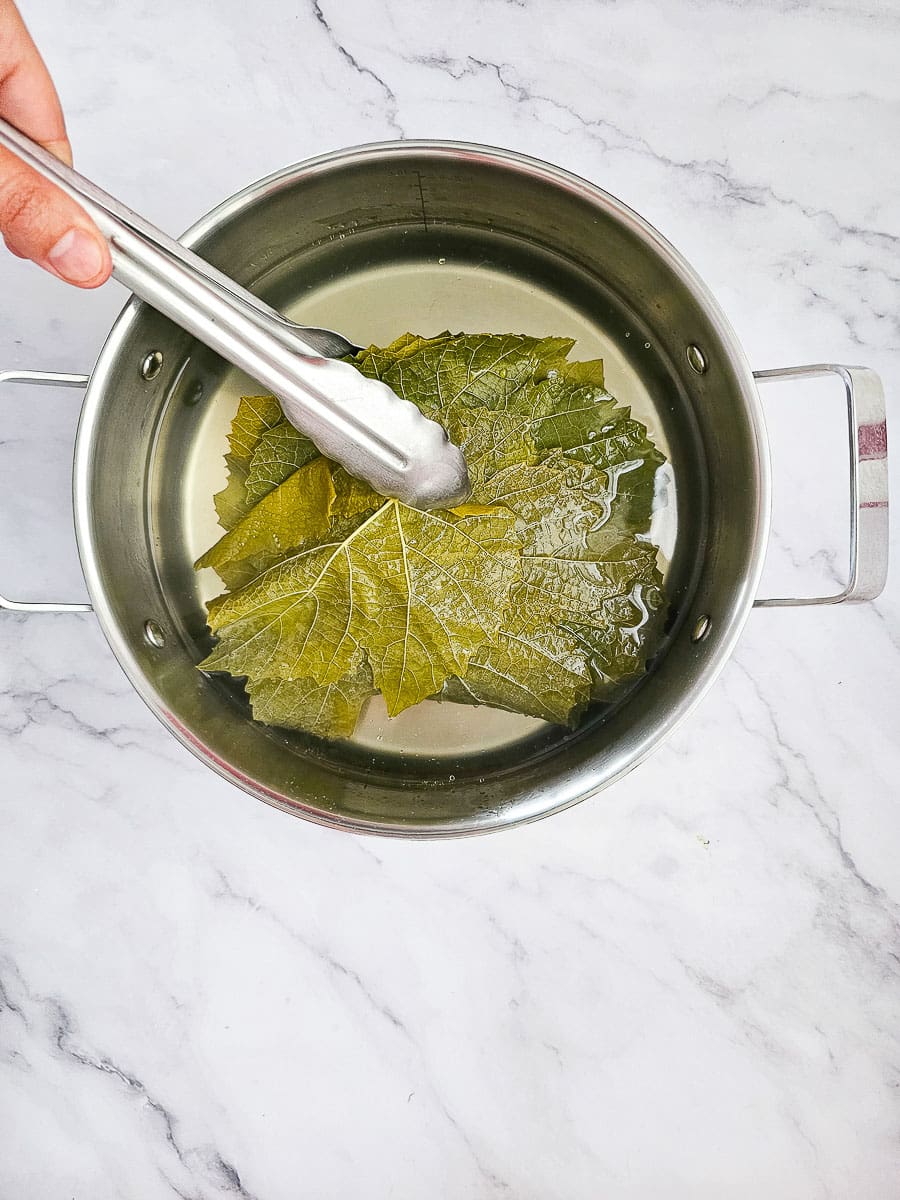
3. Turn leaves over halfway.

4. Remove from boiling water and strain. Alternatively, you can place in a bowl of iced water, then strain.
Prepare the Filling for Stuffed Vine Leaves
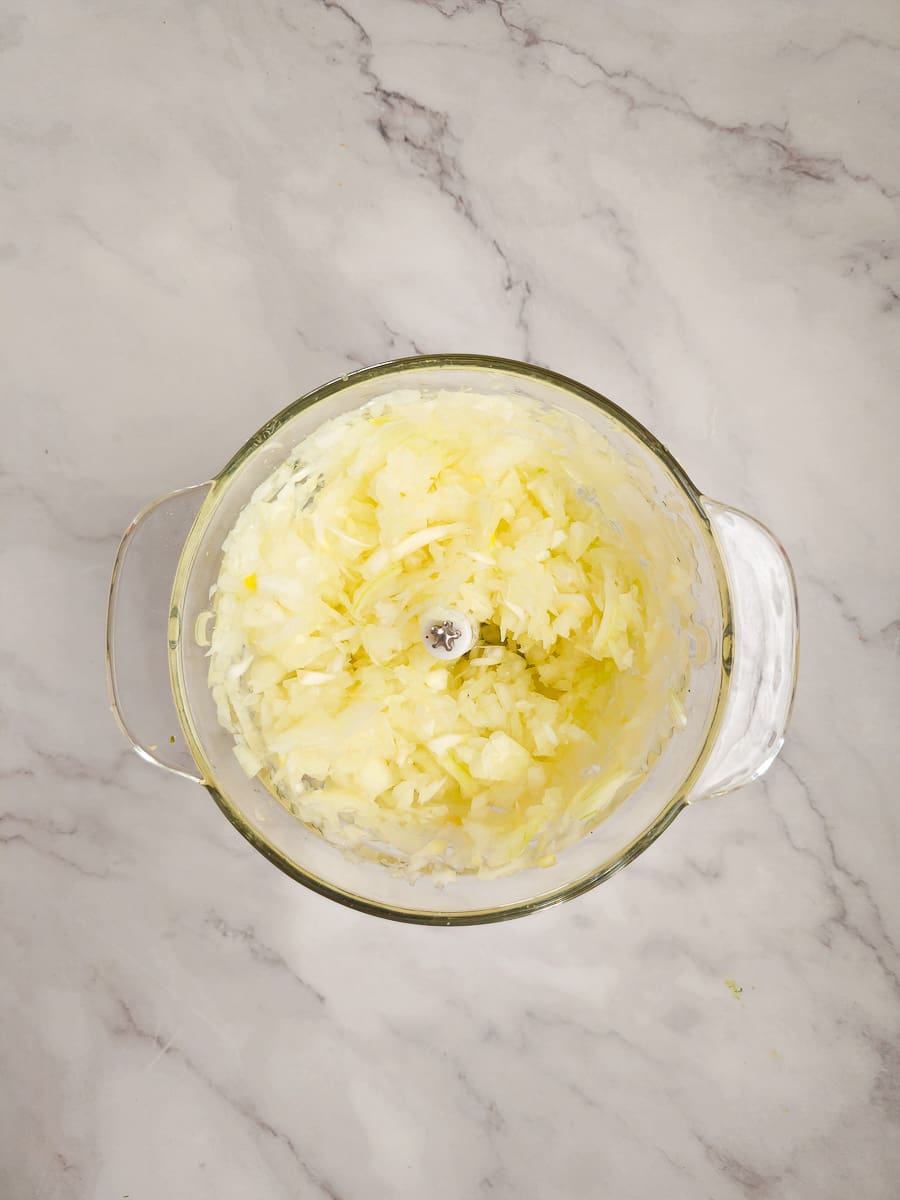
1. Finely dice the onion or place in a food processor.
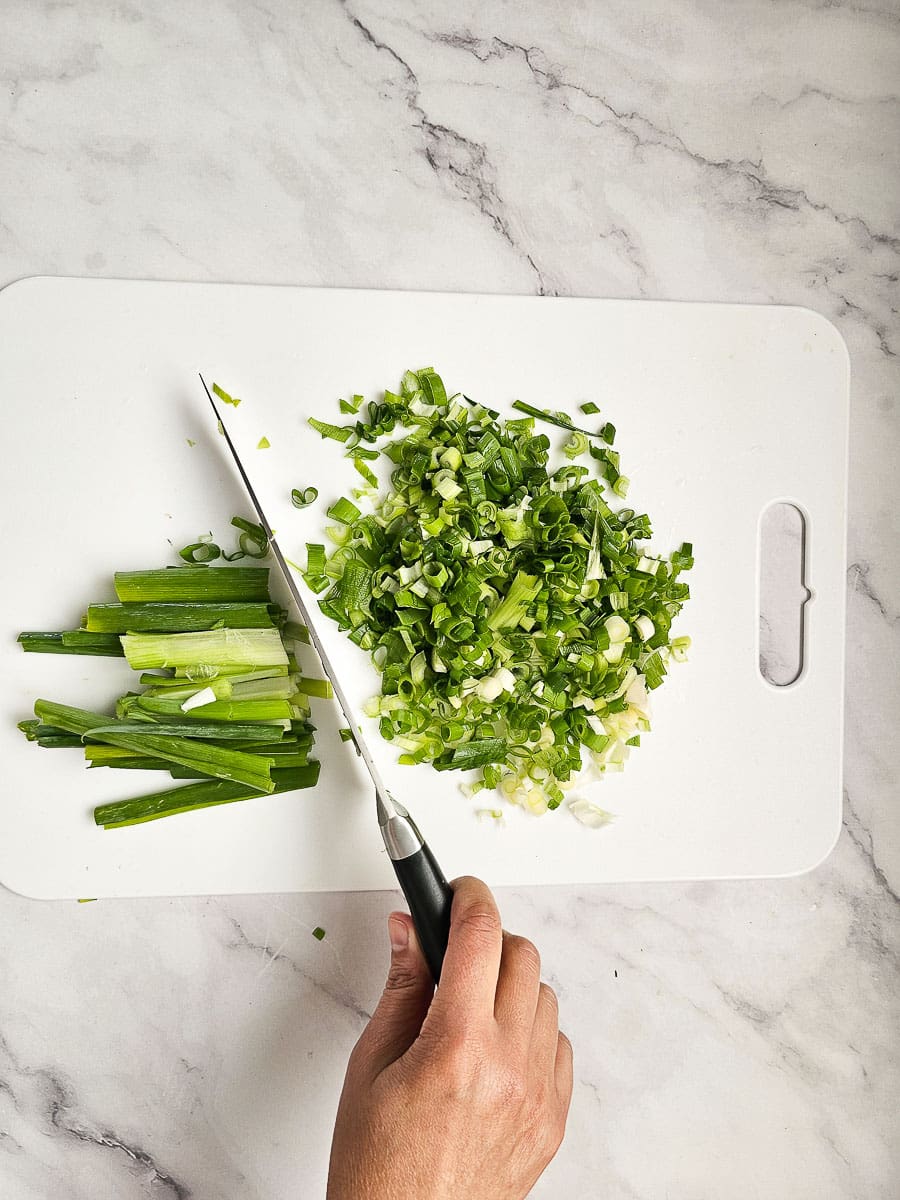
2. Finely chop the shallots.
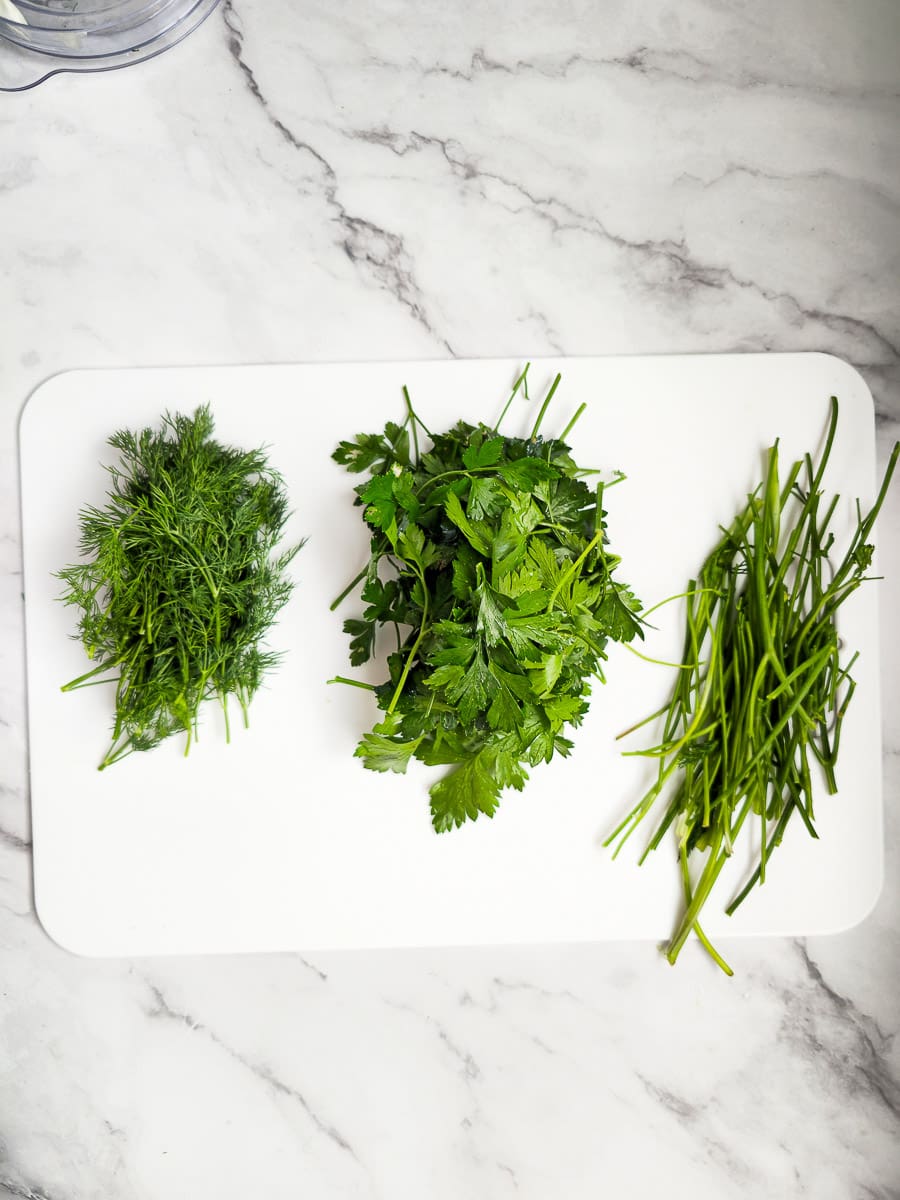
3. Remove the thick stems from the parsley and dill.

4. Finely chop the parsley and dill or place in a food processor.
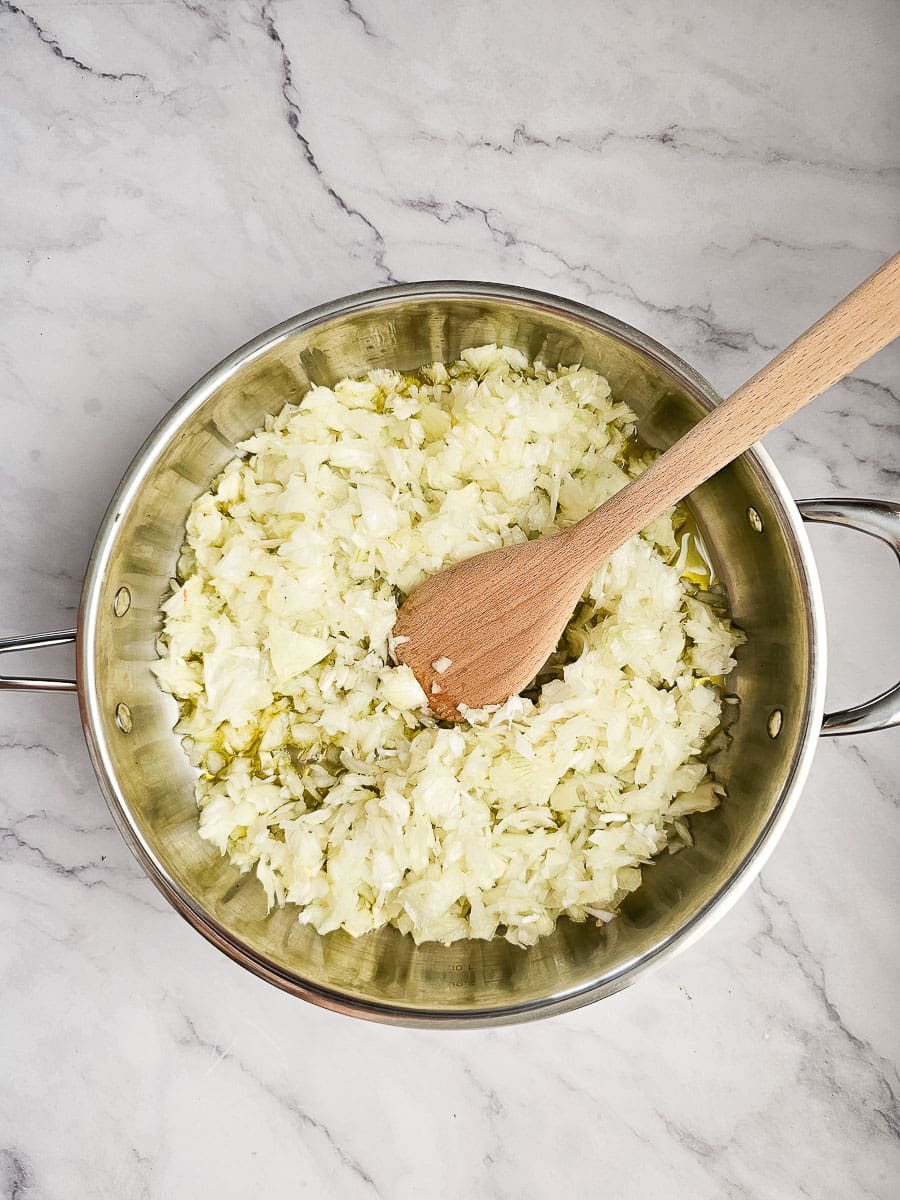
5. Heat ½ cup of olive oil in a frying pan over medium heat. Add diced onions and cook for about 4-5 minutes, or until soft and transparent.
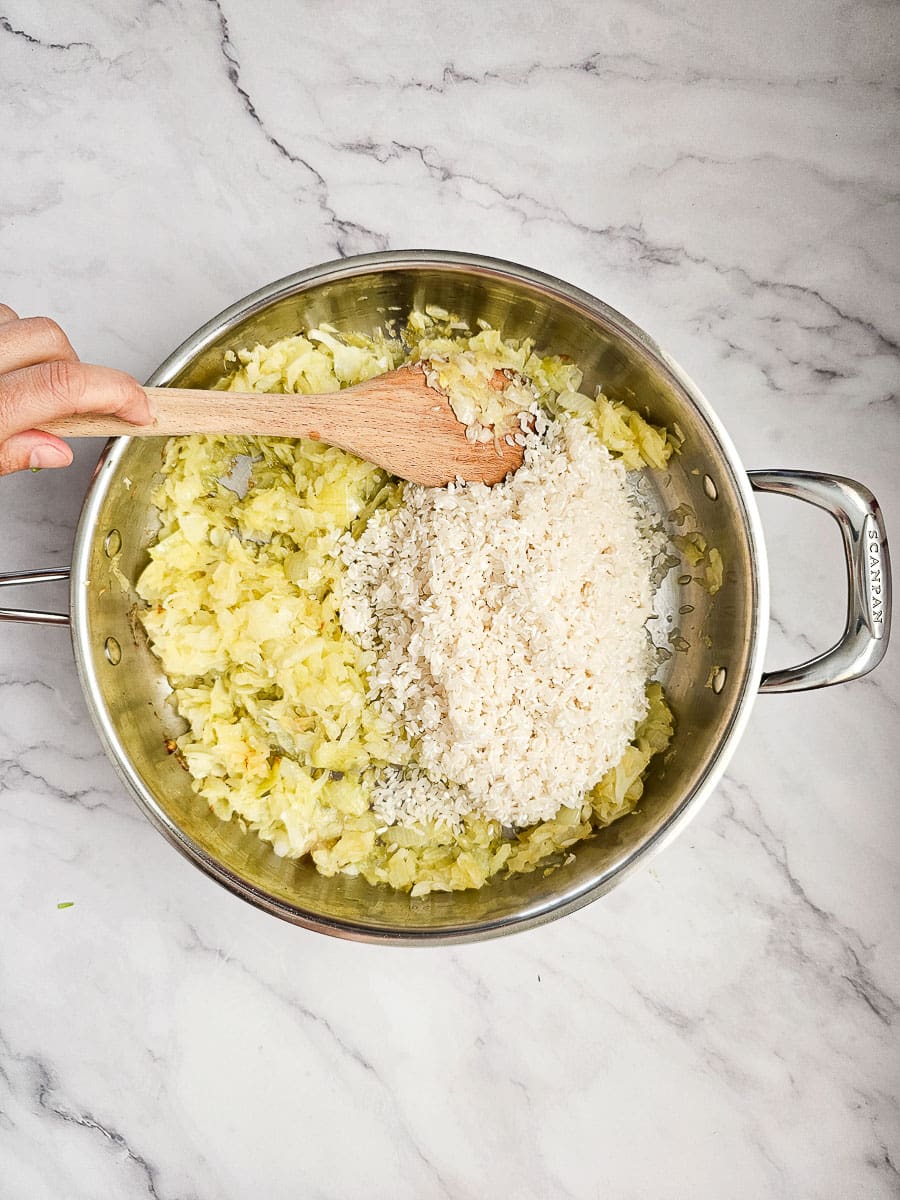
6. Add the rinsed and drained rice to the pan, stirring for 1-2 minutes.
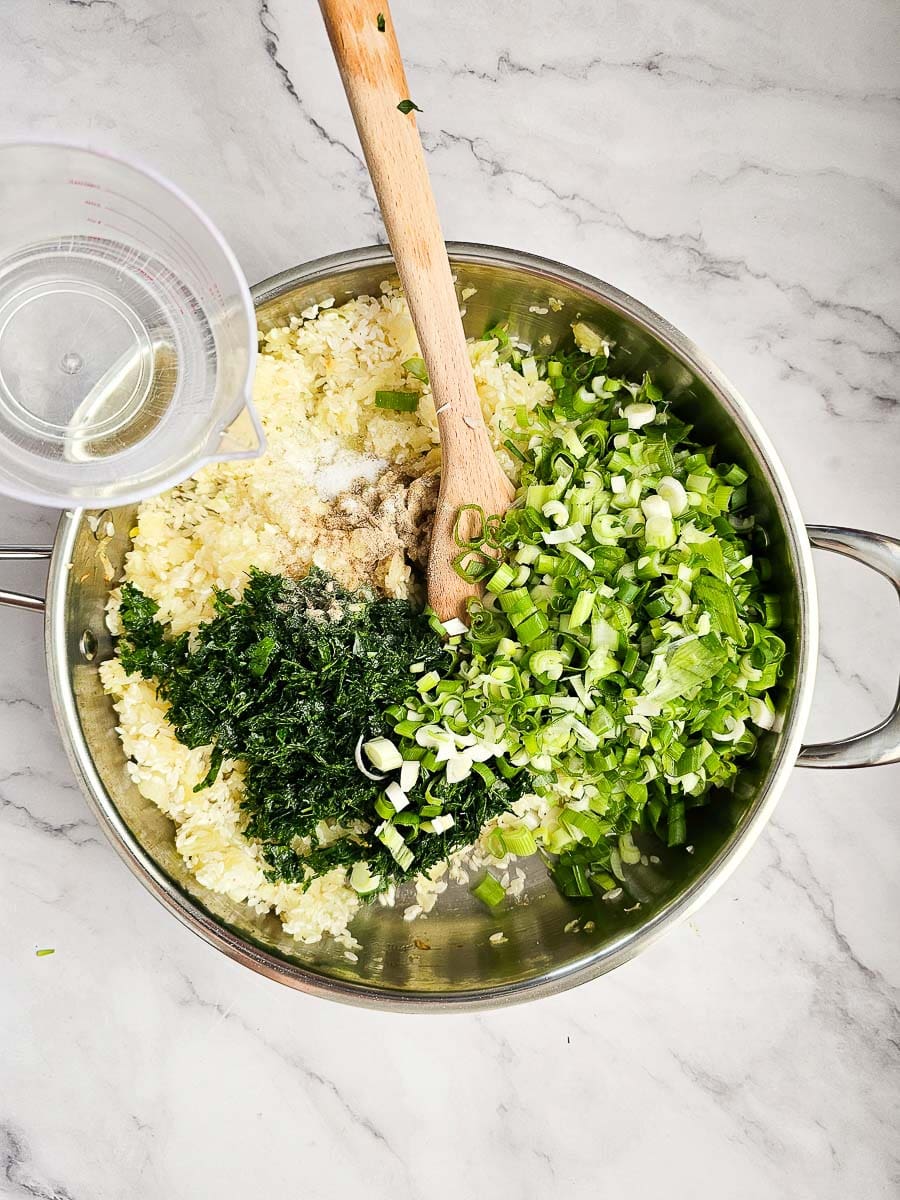
7. Stir in the shallots, parsley, dill, salt, pepper, and 1 cup of water.

8. Sauté for 2-3 minutes, or until the water is absorbed. Set aside to cool slightly.
Assemble the Stuffed Vine Leaves
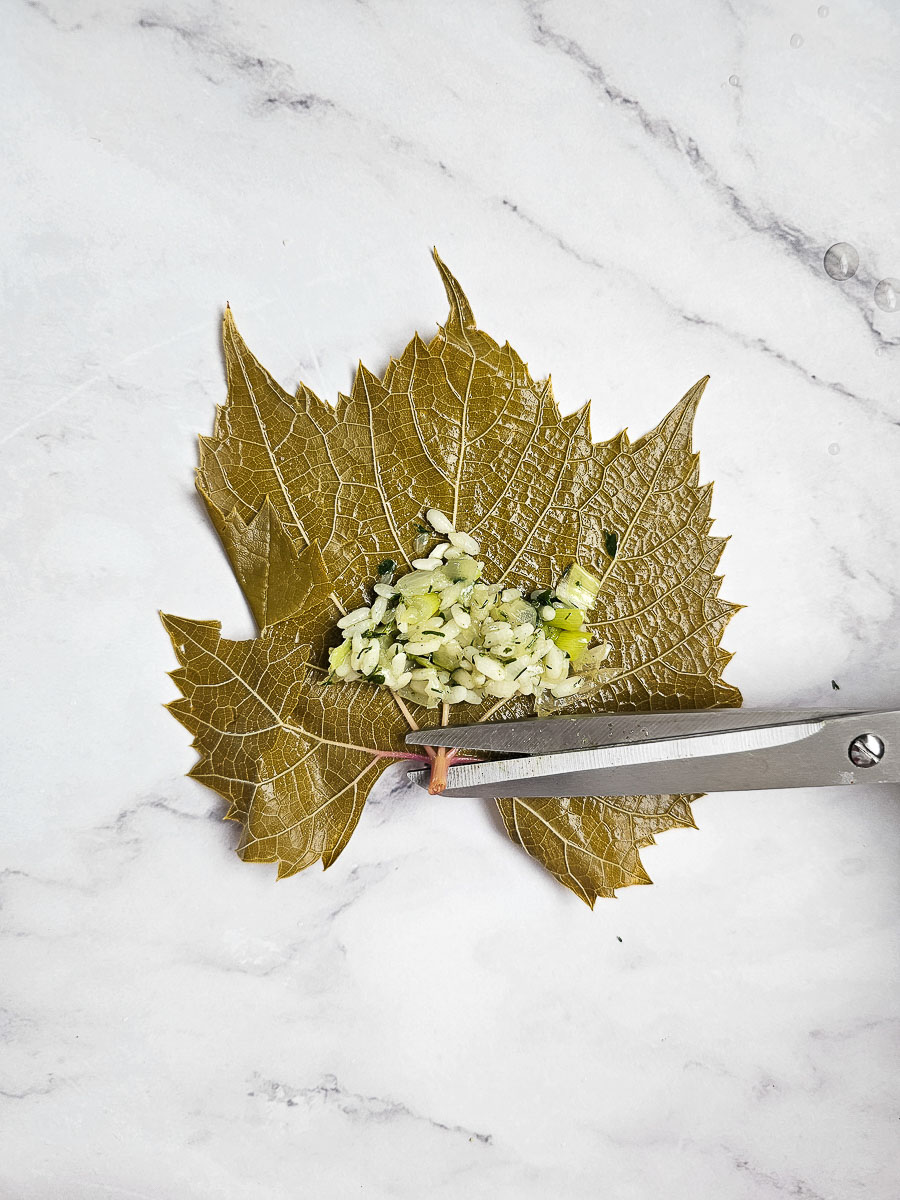
1. Trim any stems from the vine leaves if needed, then place each leaf shiny side down.
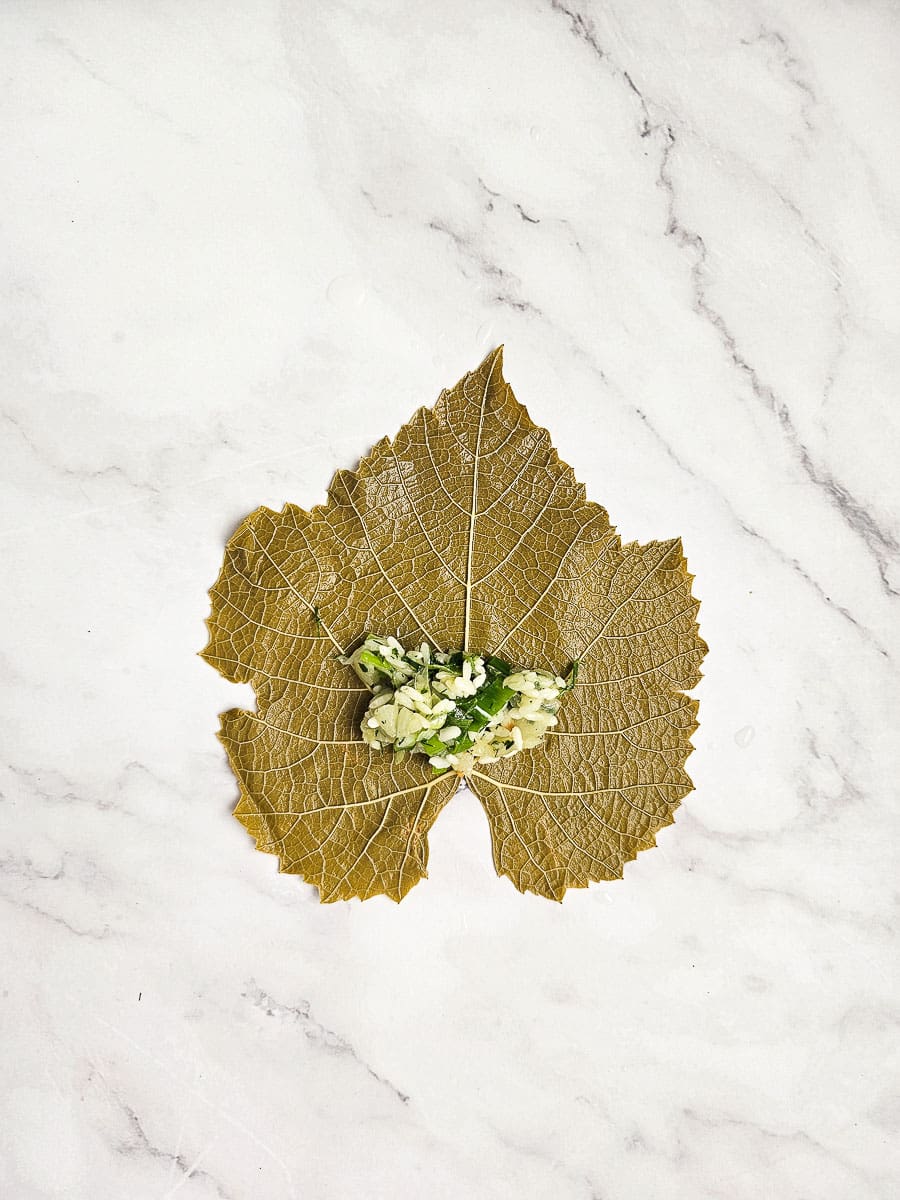
2. Spoon about a teaspoon of the filling onto the base of each leaf.
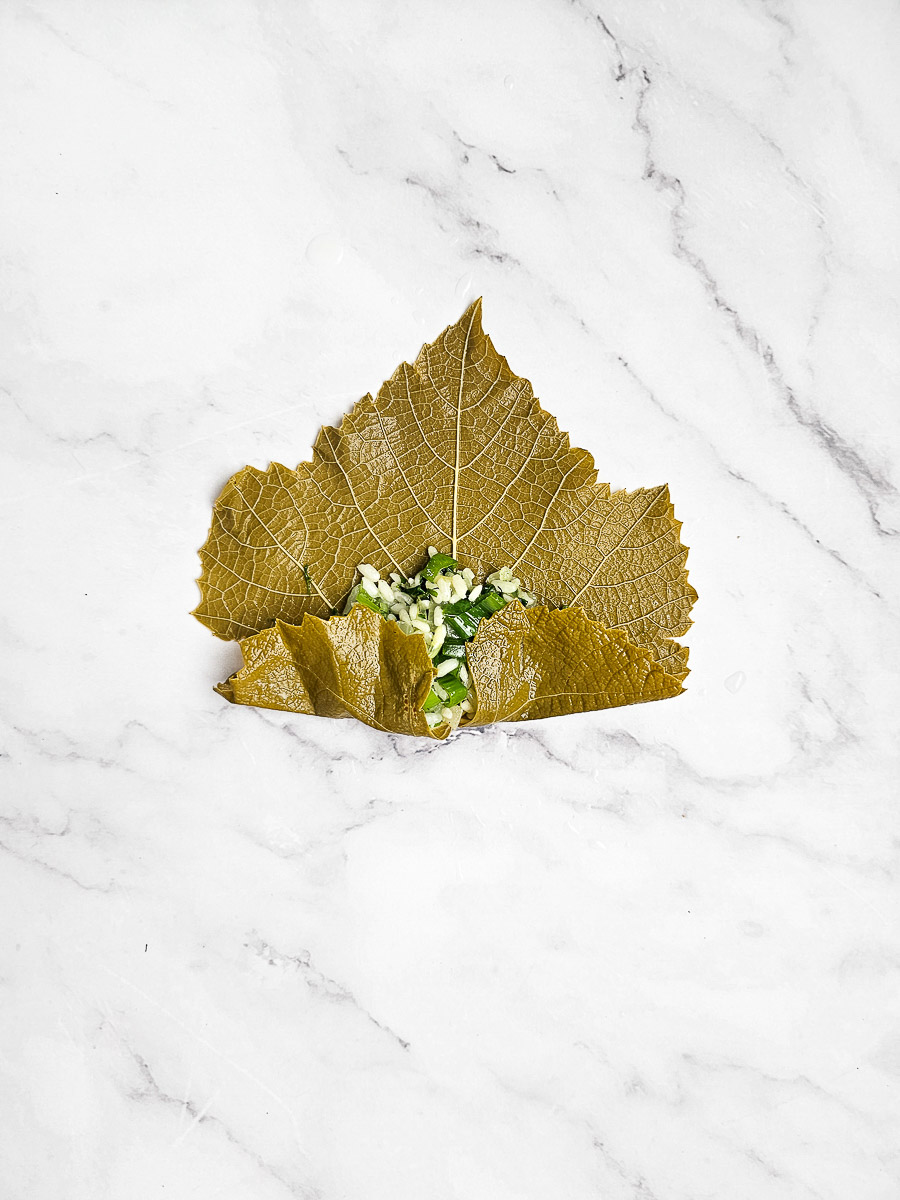
3. Fold the stem end over the filling.
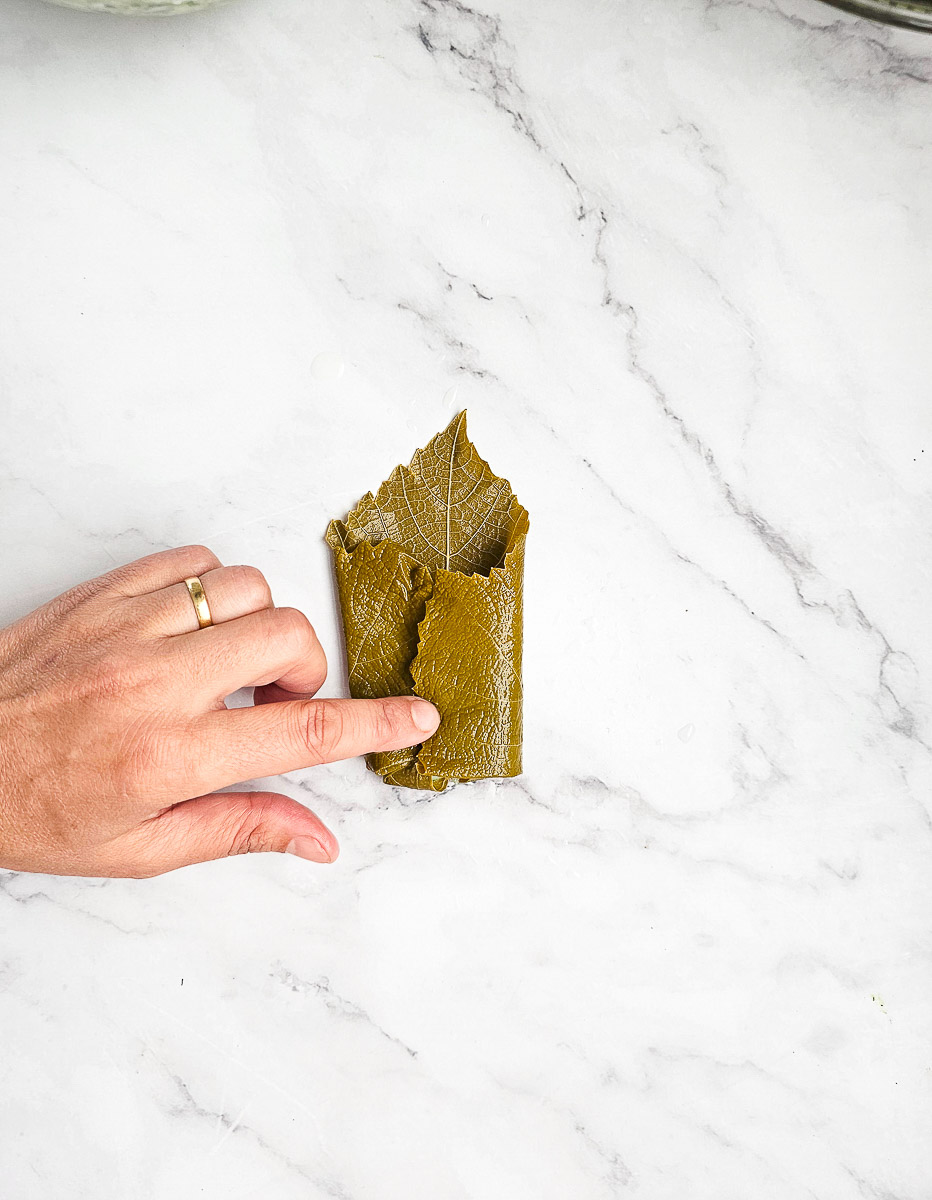
4. Tuck in the edges.
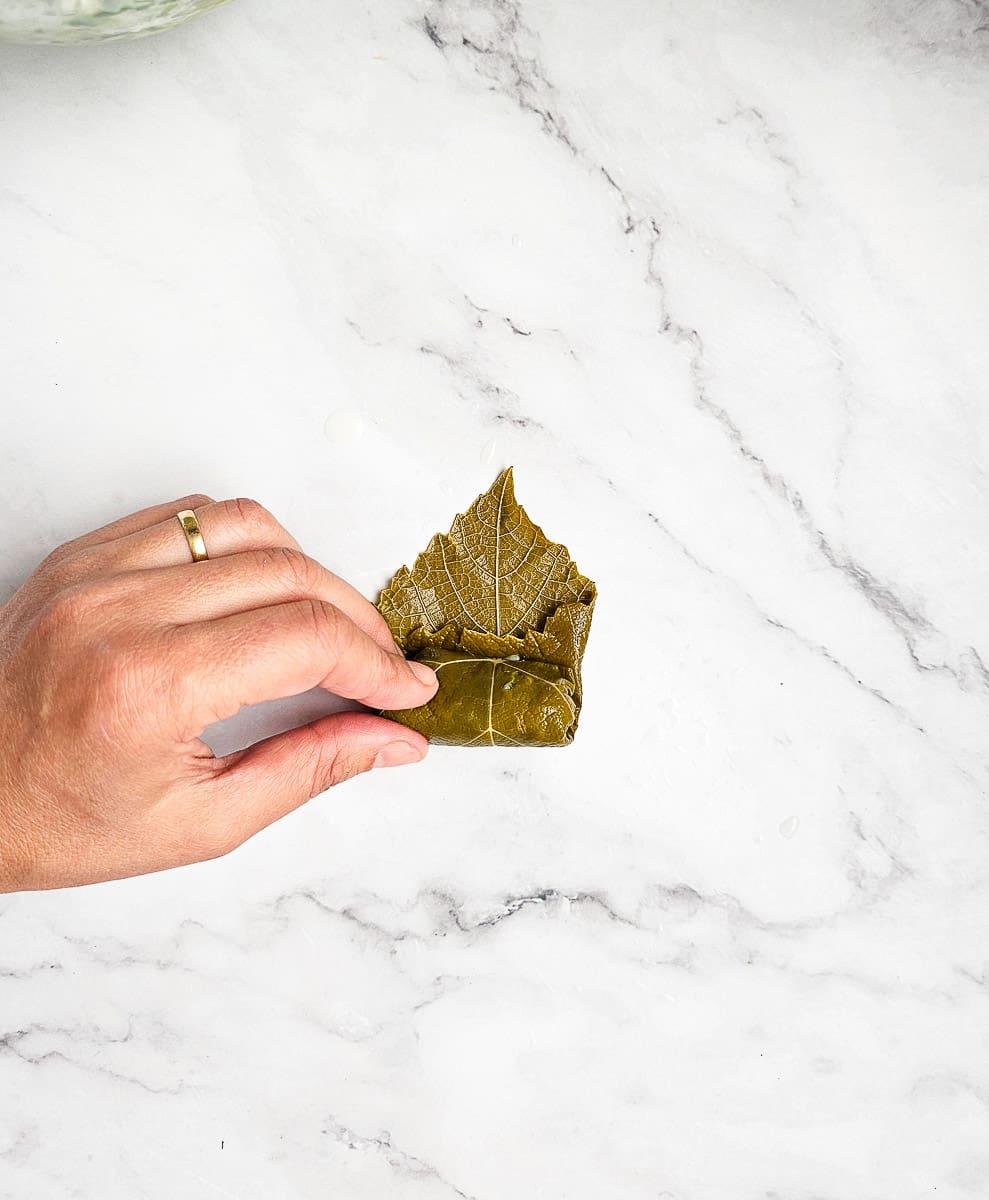
5. Roll snugly, leaving room for the rice to expand.
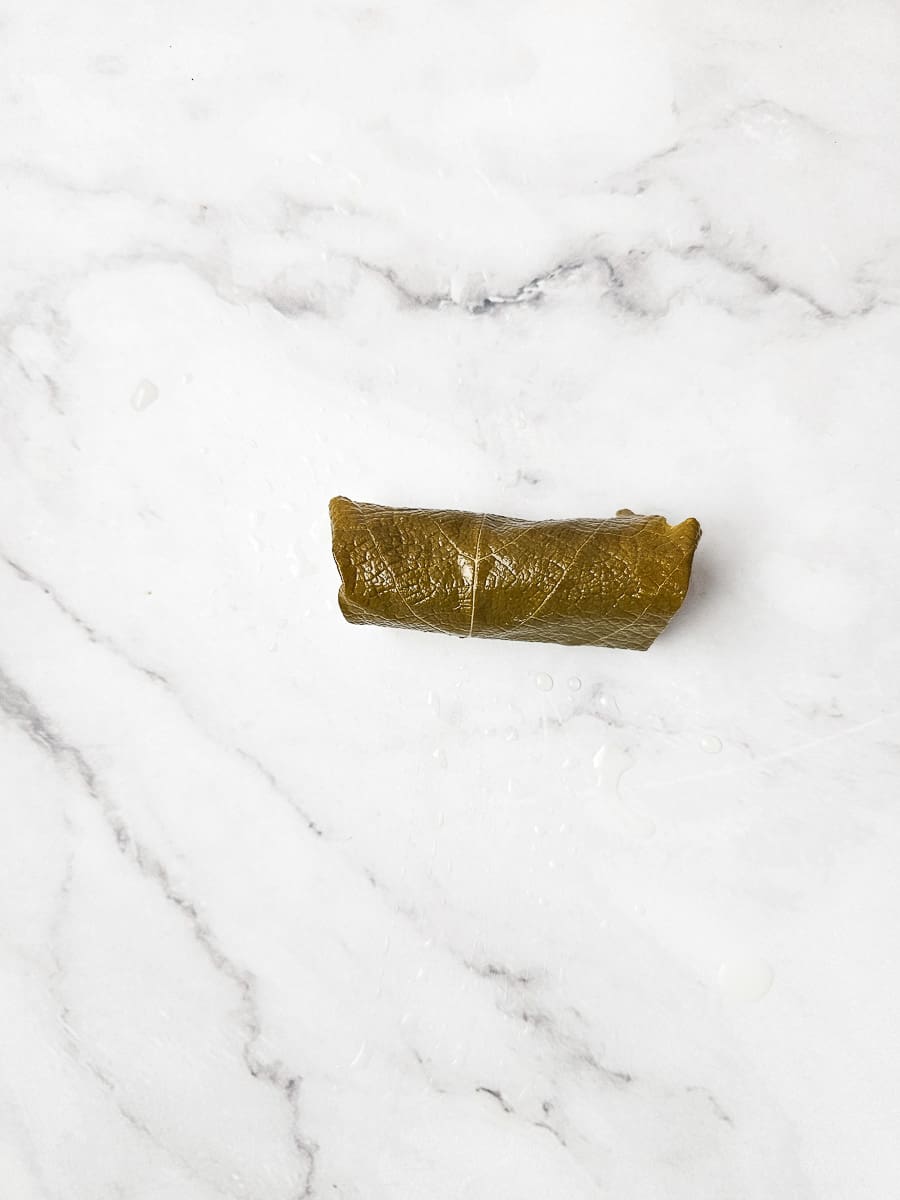
6. Repeat with all the leaves.
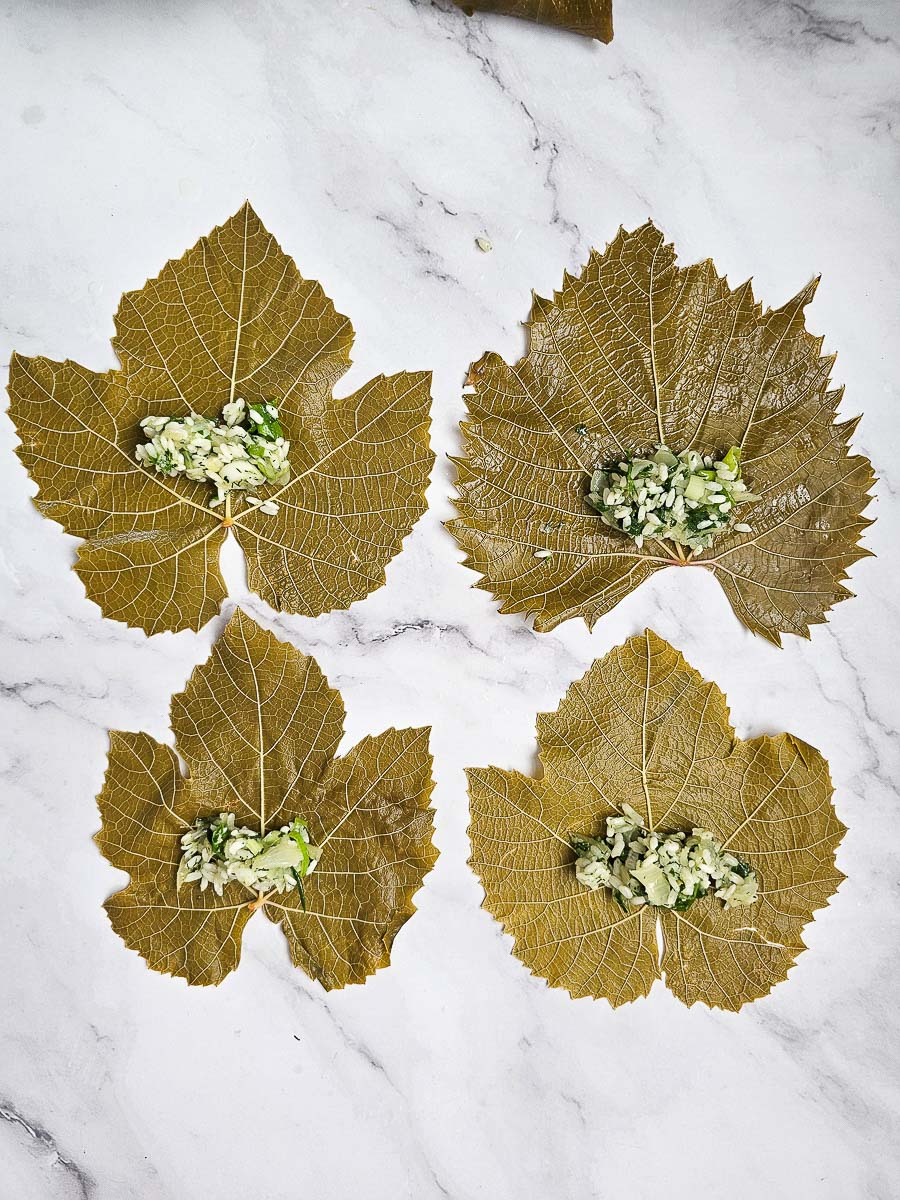
7. To save time, lay out several vine leaves (5-6 at a time) and fill and roll them in batches.
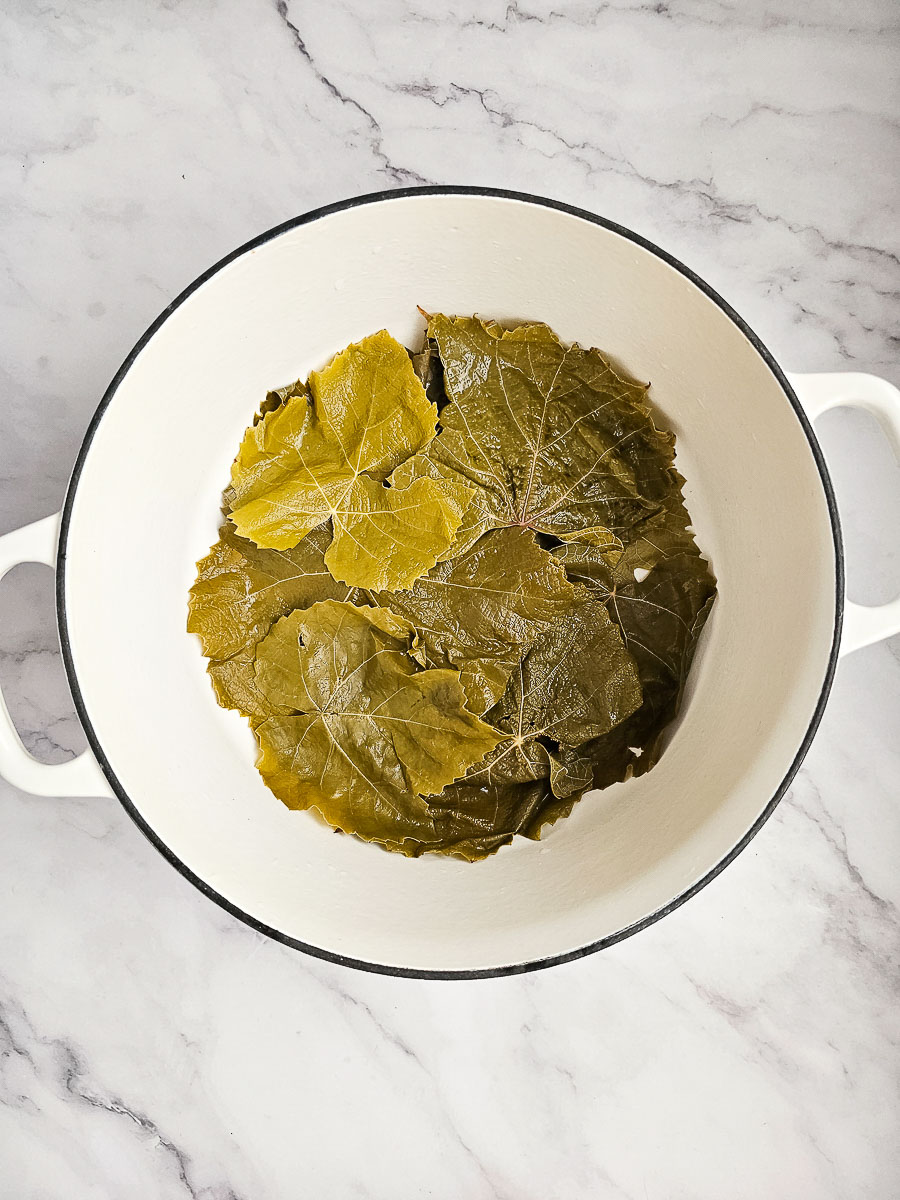
8. Line the bottom of a large saucepan with any torn vine leaves.
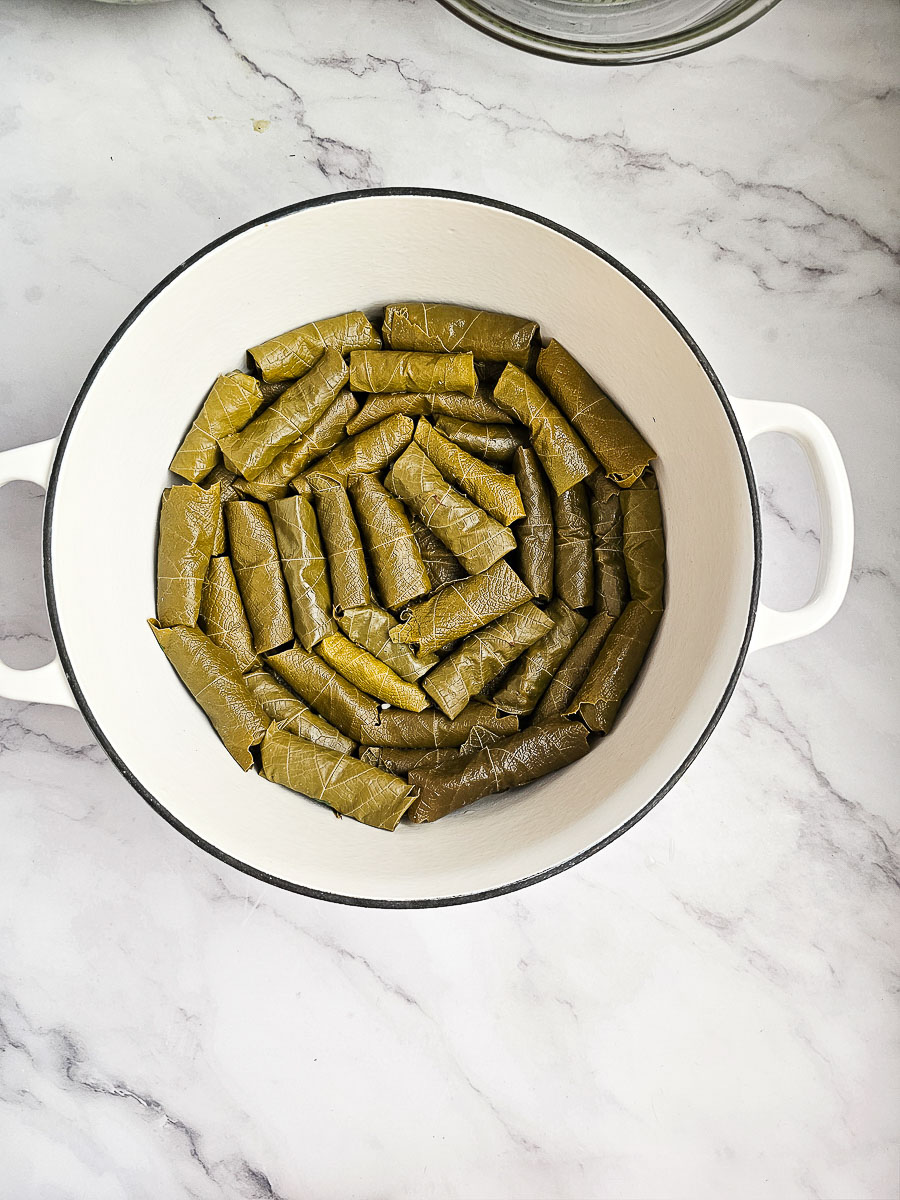
9. Arrange the stuffed vine leaves seam side down in the saucepan, packing them closely together.
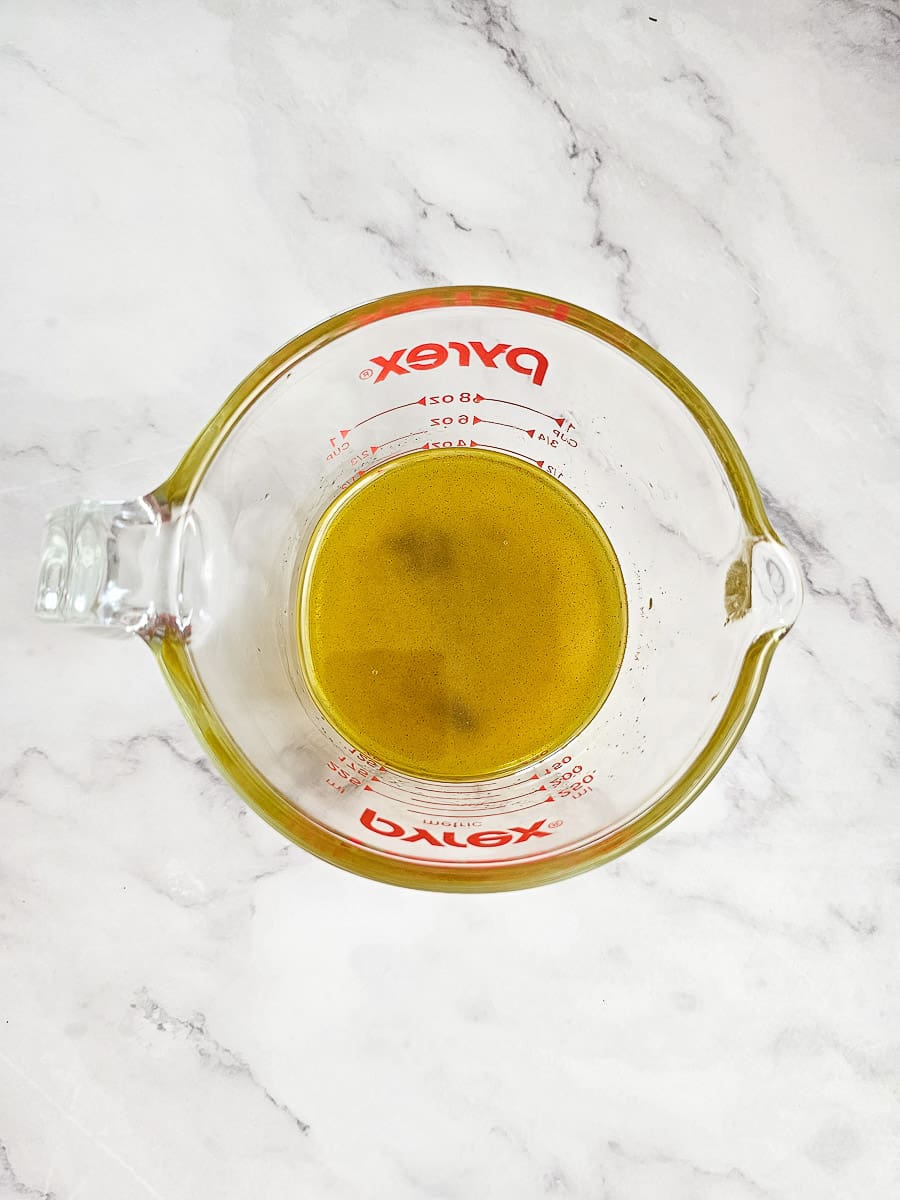
10. In a measuring jug, combine olive oil, lemon juice, salt and pepper.

11. Pour the cooking liquid over the dolmades.
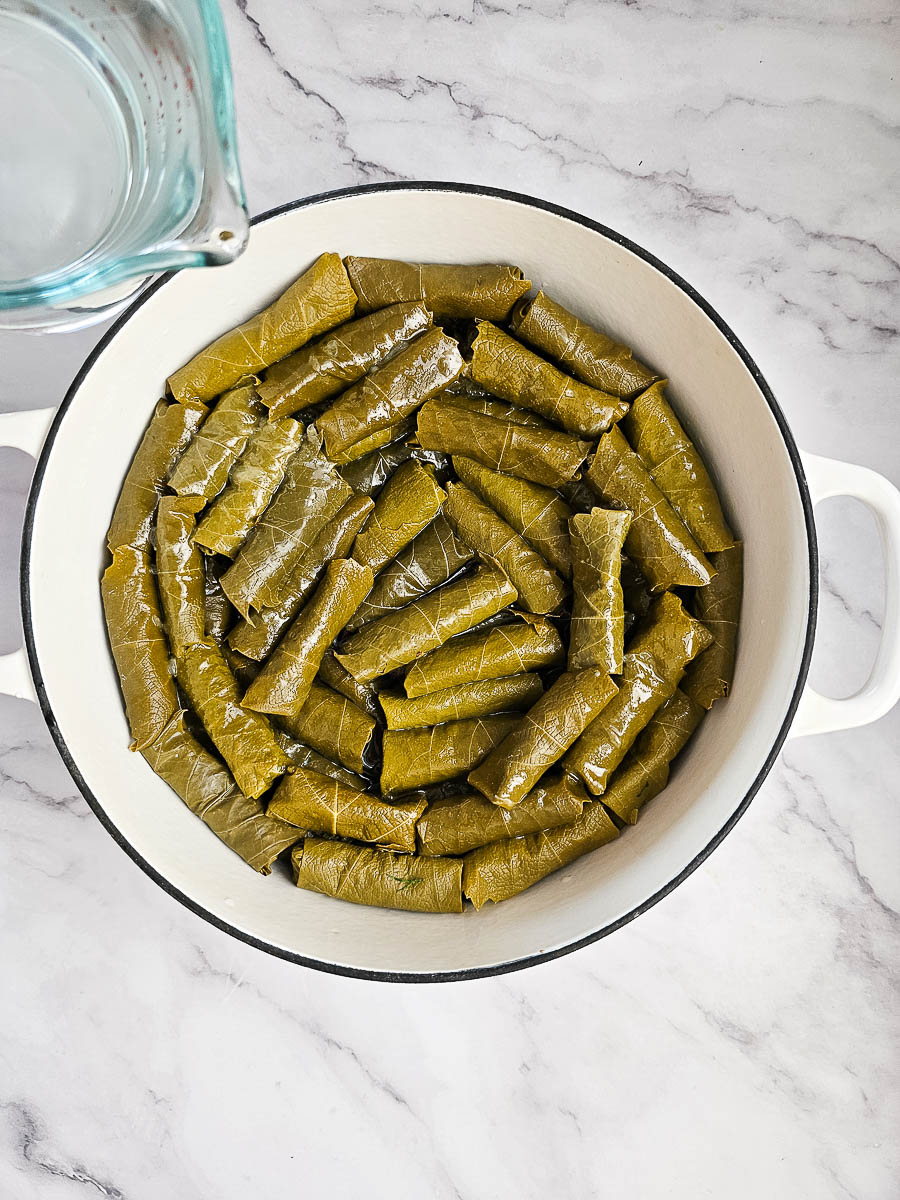
12. Pour enough hot water until it just reaches the top layer.
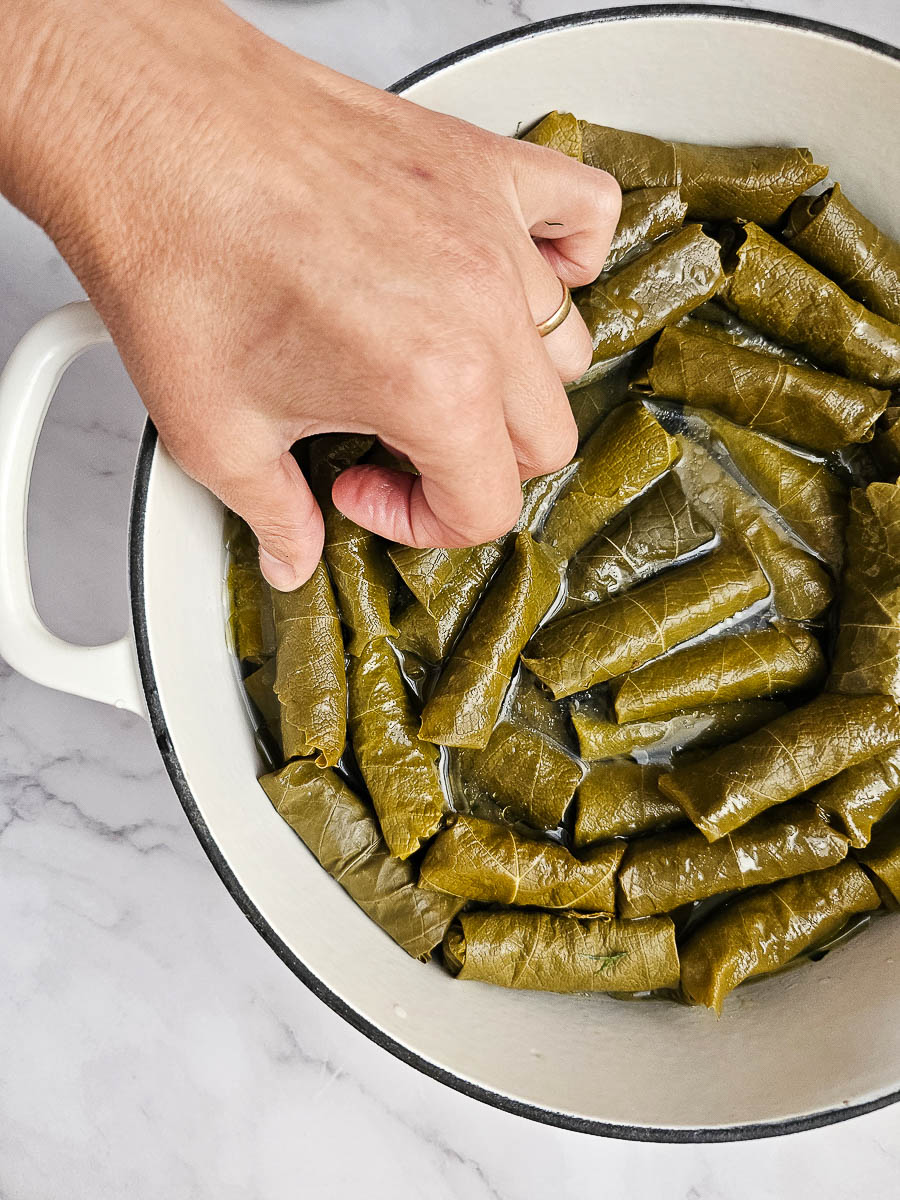
13. Add additional hot water if needed.
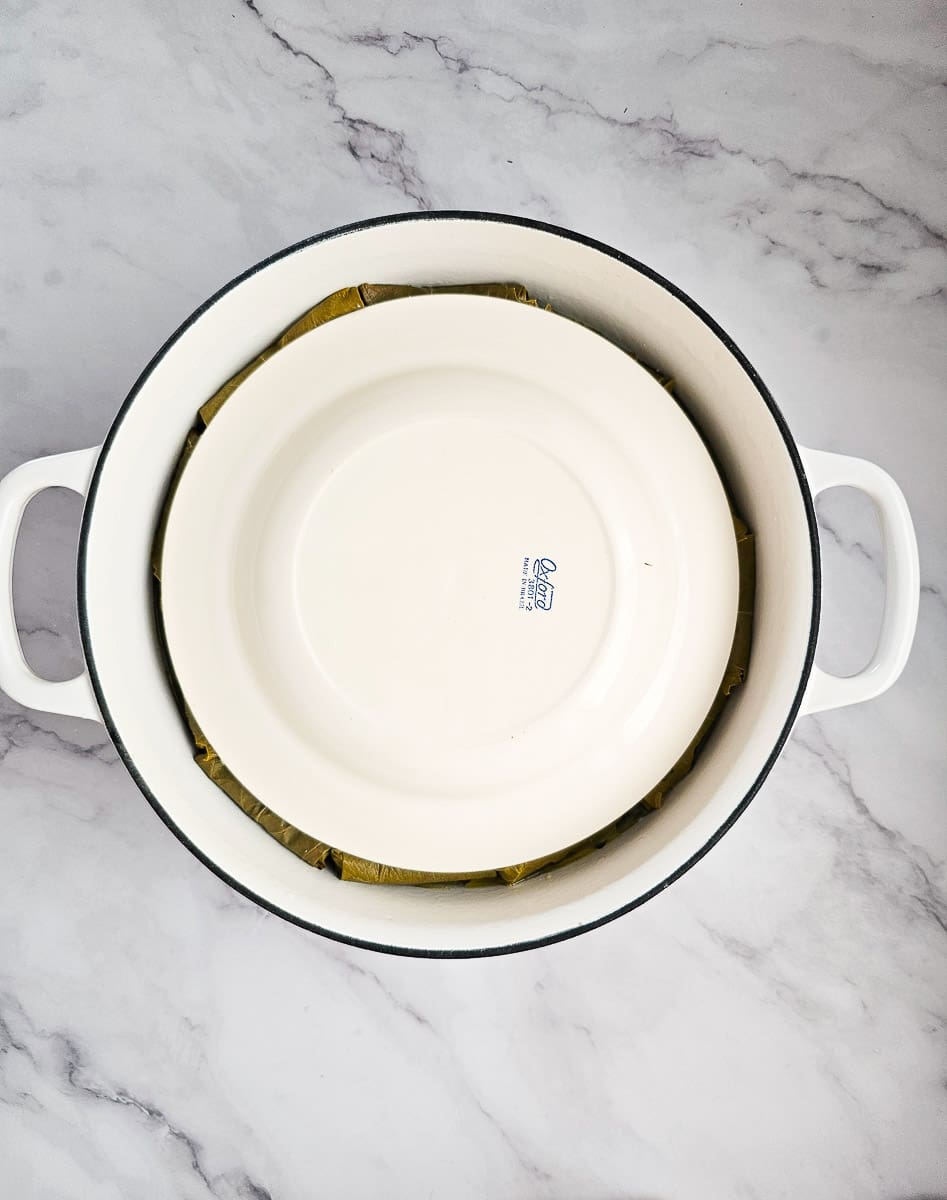
14. Place a large, inverted plate over the dolmades to keep them submerged and maintain their shape during cooking.
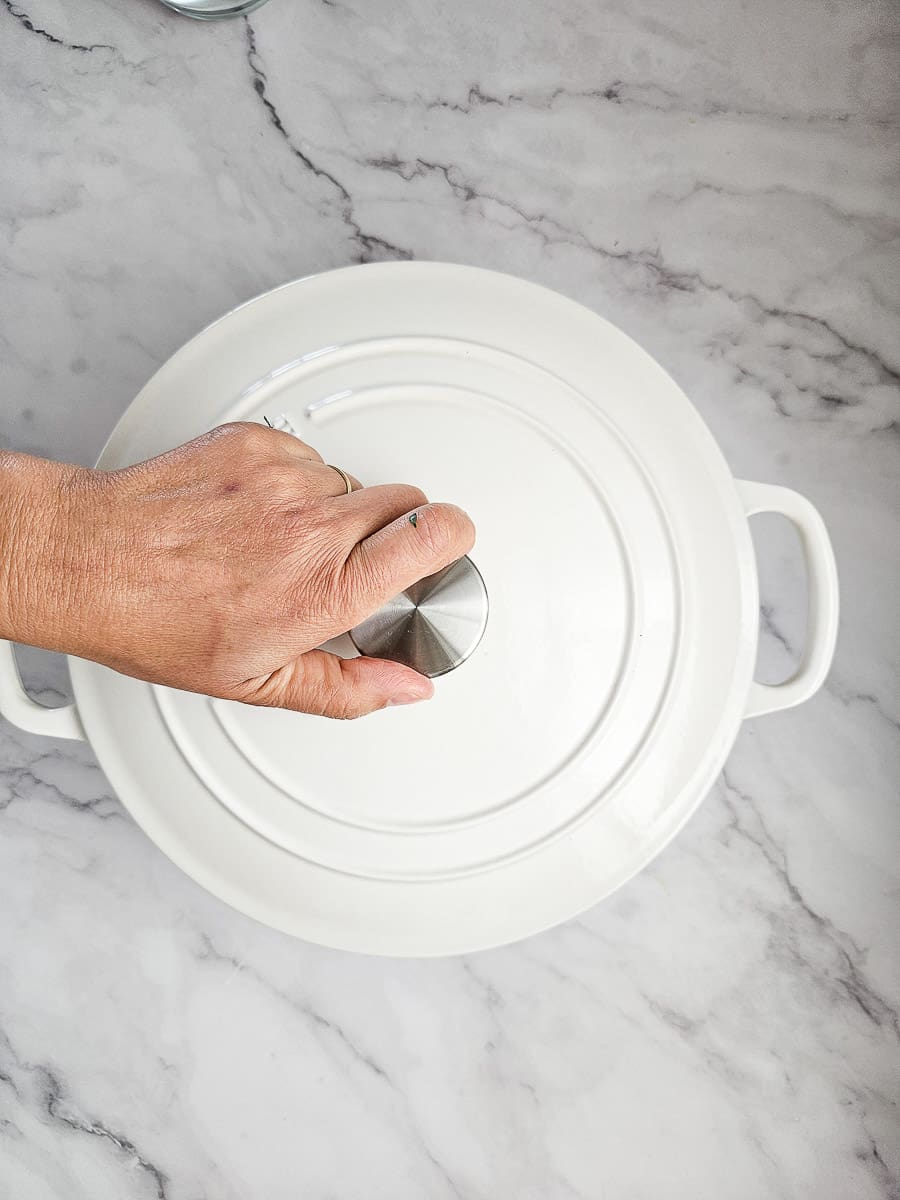
15. Cover saucepan with lid. Bring to a boil, then reduce heat to low. Cover and simmer for 40-45 minutes, or until the rice is cooked and the leaves are tender.
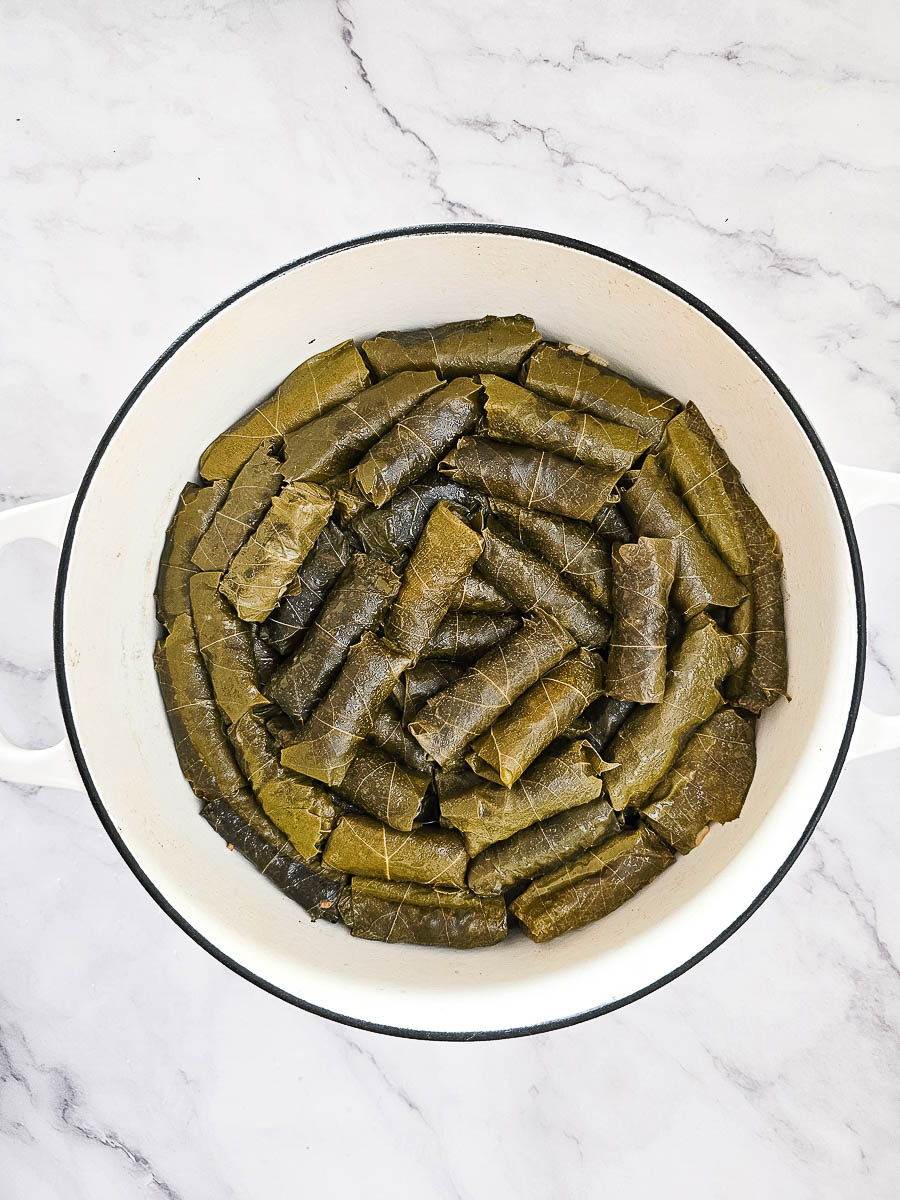
16. Remove from heat and allow the pot to cool for 20 minutes to absorb any remaining liquid.
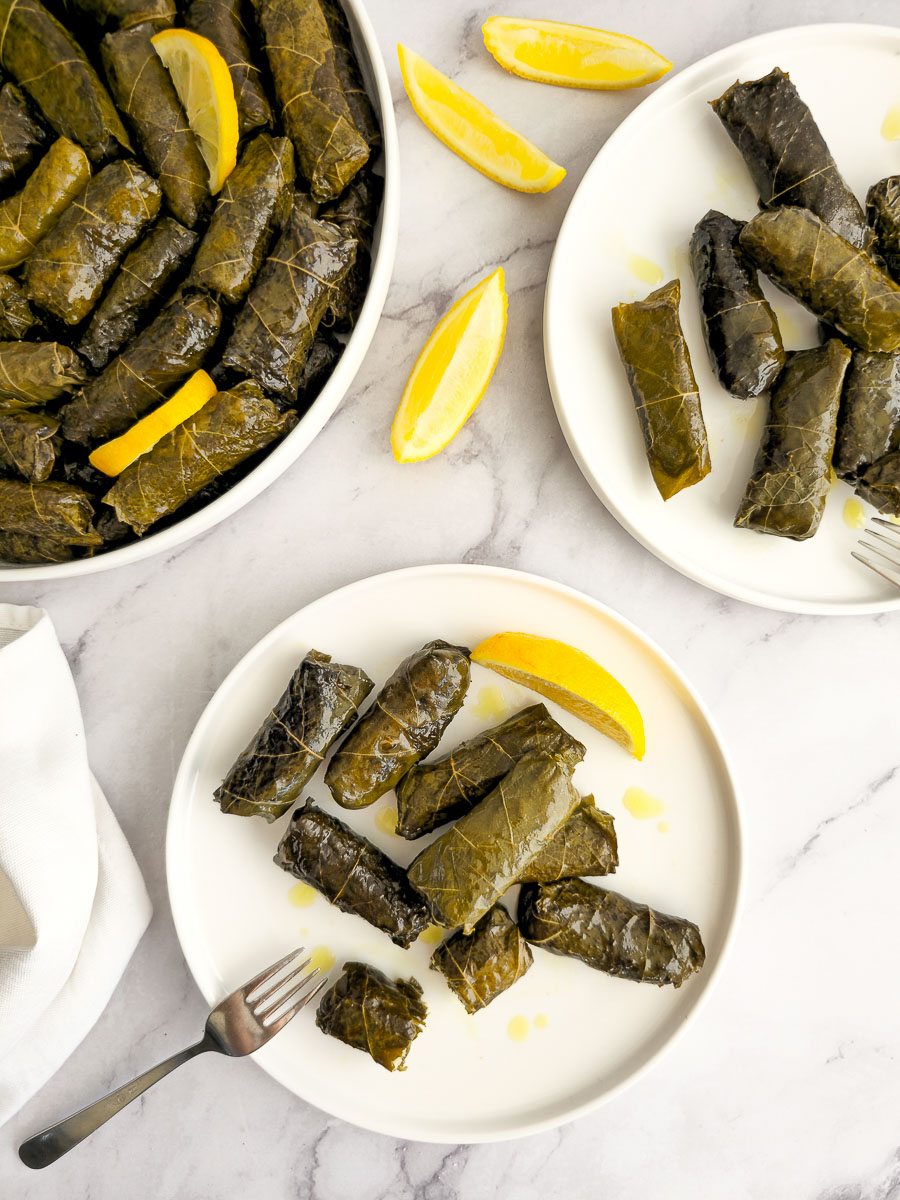
Serve the Dolmades warm or chilled, garnished with a squeeze of lemon juice. Enjoy with a side of Greek yoghurt or Tzatziki (Greek Yoghurt Dip).
If you like this dish, check out the following recipes:
Vegan Dishes:
- Greek Stuffed Tomatoes with Rice (Yemista): The combination of tomatoes, rice, potatoes and fresh herbs, baked in a rich tomato and olive oil sauce, is vegan and gluten-free.
- Greek Butter Beans Casserole (Gigantes Plaki): This nutrient-rich dish consists of creamy butter beans, onions and garlic, baked in a light tomato and olive oil sauce.
- Vegan Moussaka: This dish includes layers of thinly sliced potato, eggplant, zucchini and lentils, topped with a creamy vegan béchamel sauce. It’s the perfect plant-based alternative to traditional Moussaka!
Side Dishes:
Health Benefits of Stuffed Vine Leaves (Dolmades Yialantzi)
Stuffed Vine Leaves, or Dolmades, offer various health benefits, starting with the vine leaves themselves, which are low in calories and high in nutrients like vitamins A, C and K, supporting immune function and skin health. Additionally, they provide a good source of fibre, aiding digestion and promoting a feeling of fullness, while containing antioxidants that help protect the body from oxidative stress.
The filling adds additional nutritional value. Rice serves as a source of carbohydrates, providing energy, while onions offer vitamins and minerals, including vitamin C and B vitamins, along with potential anti-inflammatory properties. The herbs, such as parsley and dill, contribute antioxidants and enhance the flavour, making dolmades a delicious and nutritious choice for any meal.
For further reading on the health benefits of vine leaves, visit What are the health benefits of vine leaves?
Tips for making Stuffed Vine Leaves (Dolmades Yialantzi)
Choose Soft and Tender Fresh Vine Leaves
When selecting fresh vine leaves, choose tender, soft, light-green leaves without blemishes for the best results. If the leaves feel tough, blanch them for an additional 5-10 minutes to achieve a softer texture; otherwise, your rice may cook perfectly while the vine leaves remain tough.
Should I Rinse and Blanch Vine Leaves that are Stored in Brine?
If using bought vine leaves that are soaked in brine, it’s best to rinse them well under cold water and blanch for 1-2 minutes. This helps to remove excess salt and softens the leaves, making them easier to roll.
Line the Base of the Pot with Vine Leaves
To prevent the rolls from catching at the bottom of the pot, line the bottom with vine leaves. I use any torn vine leaves that I have for this purpose. Alternatively, you could peel and slice a couple of potatoes and line the base of the pot with the potatoes.
Roll Tightly but Not Too Tight
When rolling the vine leaves, aim for a snug fit but avoid rolling too tightly, as the rice will expand while cooking. This ensures that the filling stays intact and the leaves don’t burst during cooking.
Use a Plate to Weigh Down the Rolls
Placing a large, inverted plate over the stuffed vine leaves in the pot helps to keep them submerged in the cooking liquid and maintains their shape. This step is crucial for even cooking.
Let the Dolmades Rest
After cooking, allow the dolmades to rest for at least 20 minutes before serving. This resting time helps the flavours meld and allows any remaining cooking liquid to be absorbed, resulting in a more flavourful dish.
Converting Whole Leaf Herbs to Chopped Herbs
A helpful guideline for converting whole leaf herbs into chopped measurements is to estimate that ¼ cup of fresh leafy herbs will typically yield approximately 1 ½ tablespoons of finely chopped herbs.
Can I Prepare this Recipe Ahead of Time?
Definitely! This recipe does take a bit of time to prepare. You can prepare the filling ahead of time and blanch the vine leaves, then cool slightly and store both in the fridge. Alternatively, you could roll the vine leaves and store them in the fridge until you’re ready to cook them.
Storage
Leftovers can be stored in the refrigerator for up to 3 days or frozen for up to 3 months. To reheat, thaw overnight in the fridge and warm in the microwave until heated through.
Serving Suggestions
Stuffed Vine Leaves are a staple on our family table during special occasions, from Christmas and Easter to any celebration throughout the year. You can enjoy them as an appetiser served warm or chilled with a squeeze of lemon. They pair wonderfully with a side of Greek yoghurt or Tzatziki (Greek Yoghurt Dip). When I make them as a main dish, I like to add a few light green zucchinis filled with the same rice mixture to the pot for extra variety. Alternatively, you can serve Stuffed Vine Leaves with Greek Lemon Potatoes, Greek Meatballs (Keftedes), or Biftekia (Greek Beef Patties) for a more substantial meal.

